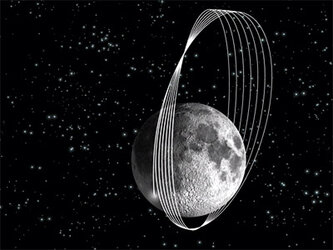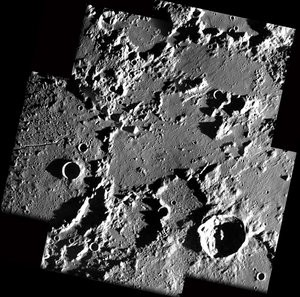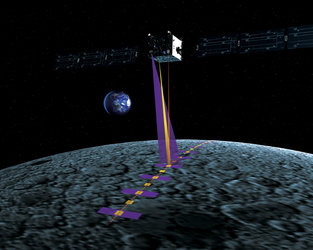SMART-1 Impact Frequently Asked Questions (FAQs)
Like most of its lunar predecessors, SMART-1 concluded its scientific observations of the Moon through a small impact on the lunar surface. This was planned to take place in the lunar Lake of Excellence, located at mid-southern latitudes on the Moon’s near side.
The actual SMART-1 impact took place on 3 September 2006 in the course of the spacecraft’s 2890th orbit around the Moon. SMART-1 sent its last signals to Earth at 07:42:21:759 CEST (05:42:21:759 UT), and the JIVE radio telescope from Hobart, Tasmania, measured a loss of signal a few moments later, at 07:42:22.394 CEST (05:42:22.394 UT).
1. What special manoeuvres did/do you have to perform up to impact?
If left on the course of its lunar orbit, SMART-1 would have naturally hit the Moon on 17 August 2006 on the lunar far side, not visible from Earth.
A two-week series of manoeuvres that started on 19 June and concluded on 2 July allowed SMART-1 to adjust its orbit to avoid intersecting with the Moon at a disadvantageous time from the scientific point of view, and to obtain a useful three-week mission ‘extension’.
A further series of minor manoeuvres were performed on 27 and 28 July, with additional opportunities for minor trajectory adjustments on 1 and 2 September 2006.
2. SMART-1 hit the Moon on Sunday 3 September. Why that date in particular?
The choice of 3 September for lunar impact was led by the decision to obtain further high-resolution lunar data from orbit and to allow ground telescopes to see the impact from Earth. For this purpose, the spacecraft control team at the European Space Operations Centre (ESOC) in Darmstadt, Germany performed a two-week series of manoeuvres started on 19 June and concluded on 2 July. These allowed SMART-1 to adjust its orbit to avoid having the spacecraft intersect with the Moon in mid-August on the lunar far side – a disadvantageous time and location from the scientific point of view. As mentioned, this also gave a useful three-week mission ‘extension’.
On 3 September 2006 the SMART-1 perilune, coinciding with the point of impact, was on the lunar near side (facing Earth), in an area called the ‘Lake of Excellence’, located at mid-southern latitudes. This area is very interesting from the scientific point of view - a volcanic plain area surrounded by highlands, but also characterised by ground mineral heterogeneities.
At the time of impact this area was in the dark, just near the terminator – the line separating the lunar day-side from the night-side. The region was shadowed from the Sun’s direct rays, but lit faintly by the light from the Earth – earthshine. The spacecraft’s orbit took it over the region every five hours, getting one kilometre lower at each pass. From Earth, a Moon quarter was visible at that time.
3. So, was the impact be visible from Earth?
The impact geometry on 3 September was ideal to allow ground observations. In fact, during full Moon the luminosity would have completely obscured the impact to ground observers, and during new Moon it would have been difficult as well, because new Moon is visible for only a few seconds after sunset. Furthermore, an impact in the dark favoured the detection of the impact flash.
Numerical simulations or laboratory experiments were run to help understand the impact and predict related observable phenomena - predictions were difficult because of the special conditions of the SMART-1 impact (low impact velocity - 2 km per second - and very grazing incidence).
Amateur and professional astronomers were also called to observe the site before and during the impact. The following institutes responded to the call: the network of Very Long Baseline Interferometry (VLBI) and radio observatories, the South African Large Telescope (SALT), the Calar Alto observatory in Andalucia, Spain, the ESA Optical Ground Station (OGS) at Tenerife, Spain, the CEA Cariri observatory in Brazil, the Argentina National Telescope, the Florida Tech Robotic telescopes, US telescopes, NASA IRTF, Canada—France CFHT and Japanese Subaru Auxiliary telescopes on Hawaii, as well as a number of professional and amateur astronomy telescopes around the world, and the ODIN observatory from space.
The ground telescopes also attempted to observe the dust ejected by the impact, hoping to follow the dynamics of the ejected material and to obtain physical and mineralogical data on the material excavated by the spacecraft. There was a possibility that at this grazing incidence the probe would bounce once. Then the spacecraft itself could emit as a small fireball before falling back.
The expected impact time (07:41 CEST) was good for big telescopes in South and Northwest Americas and Hawaii and possibly Australia. But if SMART-1 hit a hill on its previous pass, around 02:37 CEST on 3 September, then it could also have been observed from the Canary Islands and South America. If SMART-1 hit a hill on the pass on 2 September at 21:33 CEST, then telescopes in Continental Europe and Africa would have the advantage.
For more detailed information on the ground observations follow this link
4. How could you be sure you would hit the Moon on 3 September?
The time of impact was determined by orbit predictions following the thruster manoeuvres performed from 19 June to 2 July 2006 (plus a few trajectory correction manoeuvres performed on 27 and 28 July), taking into account the Sun-Earth- Moon perturbations that made the SMART-1 orbit perilune (point of closest approach to the lunar surface) naturally drift down about one kilometre per orbit.
In the impact orbit determination, ESA’s spacecraft control experts also took into account the tiny perturbations to the trajectory induced by the small hydrazine thrusters to offload the spacecraft reaction wheels, and some slight additional gravity perturbations. Furthermore, a slot was available for a corrective manoeuvre on 1 and 2 September 2006 if necessary, to maintain the impact time as planned to allow ground-based observations.
An uncertainty on the time of impact was however given by the still-not-completely-known lunar topography. The best lunar topography maps available are based on the data from the laser altimeter experiment (LIDAR) on board the US Clementine mission (1994), which provided the spacecraft altitude on a grid about every kilometre. The values in between were interpolated assuming that no accidental peaks are in those areas.
However, there was still a chance that an unknown peak could be just in SMART-1’s way as the spacecraft spiralled down until impact. This meant that, if encountering a relief of about one kilometre high, SMART-1 may have hit ground at 02:37 CEST (00:37 UT), when the spacecraft was flying at about 800 metres altitude. This was one orbit earlier than the estimated 07:41 CEST (05:41 UT) impact on 3 September. In other words, for SMART-1 the last lunar approaches was like low-altitude flying with incomplete terrain maps. However, thanks to SMART-1 and the next fleet of orbiters, we can continue to improve maps for future lunar exploration.
5. Isn’t it wasteful, to ‘crash’ an expensive piece of equipment, on purpose?
To break away from the Moon’s gravity and go off into deep space would have meant cancelling the science programme entirely. In fact, by the time SMART-1 had settled in its orbit around the Moon, there was enough propellant left for an orbital boost, but not for an escape. The spacecraft was a ‘true’ prisoner of the Moon.
When a spacecraft orbits around the Moon, as SMART-1 did, it is doomed by the law of gravity. Tugs from the Sun, the Earth, and irregularities in the Moon itself, all disturb its orbit. Sooner or later, any lunar orbiter will impact the Moon surface unless it has very large amounts of fuel left to be re-boosted and escape the lunar gravity.
SMART-1 had already survived far longer than the SMART-1 team expected when the mission was initially planned. Its experimental ion engine, powered by the Sun, was very efficient. By the time SMART-1 had settled into its orbit around the Moon in March 2005, there was only 7 kg of propellant left – bottled xenon gas - of the 84 kg at launch. We used all the remaining xenon in Summer 2005 to re-boost the orbit and avoid an early impact originally due on September 2005. As a result, SMART-1 gained an extra year of operational life in its lunar orbit.
Once SMART-1 had consumed all of its xenon propellant, we could not boost the orbit again, in any big way. Left to itself, SMART-1 would have made its impact landing on 17 August 2006 on the far side of the Moon. Not very exciting for astronomers or people that wanted to watch the impact! So mission control decided to gain three more weeks of operations in a very clever way by using the hydrazine thrusters - small rockets usually operated just to re-orient the spacecraft – in combination with the reaction wheels. This lifted the orbit enough to move the impact site to the near side of the Moon, where observers on the Earth could see the event.
6. Why didn’t you send SMART-1 off into distant space? [see also previous question]
To break away from the Moon’s gravity and go off into deep space would have meant cancelling the science programme entirely. In fact, by the time SMART-1 had settled in its orbit around the Moon, there was enough propellant left for an orbital boost but not for an escape from the Moon gravity field. The spacecraft was a ‘true’ prisoner of the Moon.
7. Some people may think that having SMART-1 hit the Moon on purpose is rash, perhaps dangerous. Did ESA considering any possible threat to the Earth?
There was no danger to our planet. SMART-1 was not big enough or fast enough to knock any rocks off the Moon which might have been capable of reaching the Earth - at impact, the spacecraft vertical speed was only 70 km per hour, which is less than some ski jumpers achieve.
Just as SMART-1 already belonged to the Moon, and obeyed lunar gravity, the same would be true for any material thrown up on impact. It cannot escape from the Moon.
8. But wouldn't the impact of SMART-1 harm the Moon?
Nearly 50 years ago the Russian Luna-2 spacecraft was the first human-made object to hit the Moon. That was in 1959. Since then many other objects have done the same, and SMART-1’s impact was softer than that of any human-made impactor before it.
When it arrived at the Moon’s surface, SMART-1 was travelling at 2 km per second. That is much slower than a natural meteoroid - for instance Leonid meteoroids arrive on the Moon at 70 km per second, and note that their kinetic energy increases as the square of velocity! And the spacecraft went in at a glancing angle – like a ski jumper. If we were unlucky SMART-1 might have hit a steep hill at 7000 km per hour, but what was more likely was that it would glide down over a flat part of the lunar surface, dropping 15 m in the last kilometre of forward motion. At impact, its vertical speed was only 70 kilometres per hour, which is less than some ski jumpers achieve.
It was possible that SMART-1 would skid for a short distance after impact, throwing up dust ahead of it and spraying dust out on either side like the wings of a butterfly. The crater made by SMART-1 was expected to be 3 to 10 metres wide and perhaps a metre deep. To put that in perspective, the Moon already has 100 000 craters that are more than 4 km wide and every day several small meteoroids make craters as big as SMART-1’s. So you would not notice much difference.
International rules protect other planets and their moons from possible contamination by spacecraft. The safety of any alien life, if it exists, is the main concern. ESA takes its legal responsibilities very seriously, and follows all current planetary protection rules, as established by the Committee on Space Research (COSPAR).
9. What about chemical contamination with materials from the Earth that do not belong on the Moon?
Every chemical element present on SMART-1 and in its instruments already existed naturally on the Moon. For instance aluminium and iron are very common. Hydrogen, carbon and nitrogen are much scarcer, but they arrive naturally onto the lunar surface from the solar wind and from the impacts of icy fragments of comets, which contain many elements. From this point of view, one can think of SMART-1 as an artificial comet. Furthermore, the little hydrazine left in the SMART-1 thrusters burned up immediately at impact.
10. There will still be the wreckage of SMART-1, so is the beautiful Moon to become a junkyard of old spacecraft?
We should not think of it as junk. With its relatively low impact speed, SMART-1 should be much less fragmented than the dozens of other spacecraft that have hit the Moon. Damaged certainly, and with its solar panels torn off, the main part of SMART-1 remains on the lunar surface as a monument to Europe’s exploration of space.
11. Will scientists learn anything from the impact on the Moon?
The last SMART-1 observations before impact provided new impressions of the lunar landscapes. As the impact occurred in a dark area of the Moon, we did not expect to see very much by visible light during the final descent, but we looked forward to late images from SMART-1’s final moments. Mission control received signals right up to the impact, with the spacecraft antenna pointing towards the Earth.
During close lunar approaches, the camera had oblique views of some areas that we had previously looked at only vertically, providing a sort of three-dimensional view of the surface. During the last orbits, the other instruments, including the D-CIXS X-ray telescope and the SIR infrared spectrometer, provided detailed views of some regions from very low altitudes.
Powerful telescopes on the Earth were able to see a faint flash from the impact itself, followed by a cloud of dust thrown up by the impact, perhaps 5 km wide. The dust obscured the view of part of the Moon’s surface for 5 or 10 minutes. The impact angle of one degree generated some elongated ejecta structures, with ‘butterfly wings’ on the side.
The behaviour of this cloud gave us valuable information about impact events in general, while the analysis of the light from the dust, with spectrographs in the telescopes, may detect materials dug up by the impact from just beneath the lunar surface. Astronomers had done this sort of thing before, when NASA’s Deep Impact spacecraft hit Comet Tempel-1 in July 2005; that was a far more energetic event.
The observations relied on the faint glow of earthshine – unless some of the dust cloud was thrown more than 20 km above the lunar surface. In that case, it would be lit directly by sunlight and appear far brighter for perhaps a few minutes. Amateur astronomers could be able to spot the sunlit dust cloud with their binoculars and small telescopes.
12. Whatever happens, the impact will be the end of your mission. What have you found out with SMART-1?
SMART stands for Small Mission for Advanced Research and Technology. The major technological demonstration was the first use of solar electric propulsion for interplanetary travels, in combination with gravity assist manoeuvres. Such a propulsion system will be used for ESA’s BepiColombo mission going to the planet Mercury.
SMART-1 also tested future deep-space communication techniques for spacecraft, techniques to achieve autonomous spacecraft navigation, and miniaturised scientific instruments to examine the surface of other worlds in visible, infrared and X-ray light, used for the first time around the Moon. BepiColombo and other science or exploration spacecraft will carry similar instruments.
As for our investigation of the Moon itself, SMART-1 mainly studied the past impacts that created all those craters on the Moon. Having 16 months in close orbit instead of the 4 months initially planned, SMART-1’s camera built up a large library of images of craters large and small all over the Moon, not least around the poles where previous observations were patchy. The infrared instrument measured changes in the spectra of the lunar soil, between different parts of impact craters, to reveal the composition of subsurface material bounces upwards in the centre, during the impact.
Lunar scientists suspect that the biggest impact of all was at the birth of the Moon from a huge collision between the newly formed Earth and a small planet, 4.5 thousand million years ago. The X-ray instrument on SMART-1 gathered the best information available so far about the various elements present on the lunar surface. When the results are fully analysed they may support or challenge that theory of the Moon’s origin. Although the observation phase of the mission is over, scientists will be working on the results for years to come.
13. Is that the end of the story for European missions to the Moon?
Definitely not. In 2008, India’s Chandrayaan-1 spacecraft began its journey to the Moon, equipped with the same European infrared and X-ray instruments as carried on SMART-1.
The SMART-1 team and European experts also collaborated with teams preparing new lunar missions in China, Japan, India and the United States. SMART-1 data will also help to select the sites for future landers, robotic villages and to prepare for the return of humans to the Moon.





